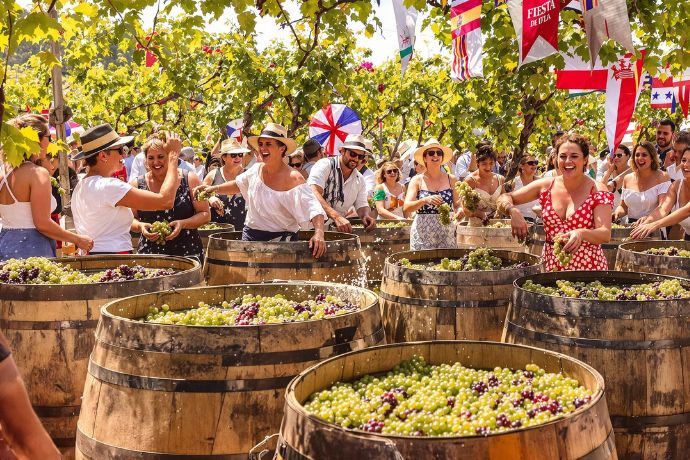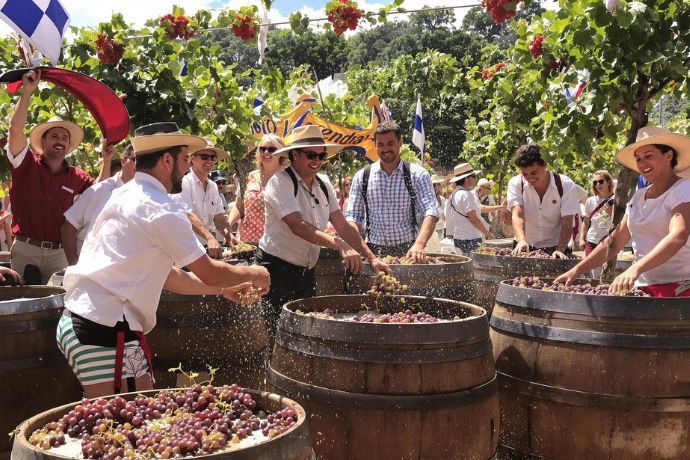 June 6, 2025 11:37 am
June 6, 2025 11:37 am
The grape harvest festival is one of the most traditional and authentic celebrations in the world of wine. It marks the beginning of the magical process of grape harvesting, essential for the production of high-quality wines and brandies. This festivity is also a tribute to the culture and effort of those who work the vineyard, celebrating the arrival of a new cycle full of aromas, flavors, and great moments.
What does the grape harvest festival consist of
The grape harvest festival is celebrated to commemorate the grape harvest, a crucial moment for wineries, as the quality of the harvest will determine the character and excellence of wines and spirits. This festivity, which holds International Tourist Interest, attracts thousands of visitors each year interested in tradition and the cultural and gastronomic activities that accompany it.
During the grape harvest festival, wine cities and towns organize parades, grape stomping, wine contests, tastings, guided tours to wineries, and musical events, creating a unique festive atmosphere. Depending on the place, the grape harvest festival can last from a weekend to several weeks, with a very varied program for all audiences.
 History of the grape harvest festival
History of the grape harvest festival
The grape harvest festival has its roots in Antiquity. Already in Greek times, the “Dionysia” were celebrated in honor of Dionysus, god of wine and fertility, where tribute was paid to the harvest and the life cycle of the vine. The Romans adapted this celebration under the name of “Bacchanalia”, honoring Bacchus, where the festivities included parades, music, dances, and banquets. These rituals had an almost sacred character, as wine was considered a divine gift.
Over the centuries, these traditions evolved in Europe and took root in the main wine-producing areas, such as Spain, France, and Italy. Thus was born the current grape harvest festival, which maintains that spirit of gratitude for the land and collective effort. Today, the grape harvest festival is synonymous with community, tradition, and celebration of the wine culture, and also the beginning of the production of such emblematic wines and brandies as Brandy Fundador.
What are the dates of the grape harvest festival 2025
The date of the harvest mainly depends on the grape variety, the type of wine that is desired and the location of the vineyards. There is not a single date for the harvest festival:
- Young white wines: The harvest is usually brought forward to pick the grape at its optimum point of freshness and acidity. In regions such as Rueda or Castilla-La Mancha, the harvest can begin in mid-August.
- Aged red wines: The harvest is delayed to obtain a higher concentration of sugars and aromas, and is usually celebrated from the end of September to October, depending on the area and the climate.
- Fortified or liqueur wines (like those from Jerez): The harvest of the Palomino grape is usually carried out at the beginning of September, ensuring the ideal ripening for the production of finos, olorosos.
This explains why there are harvest festivals at different dates and places: each denomination of origin adapts the harvest to the specific needs of the wine that wants to be produced. Thus, you can enjoy these festivals from the end of August until well into October, depending on whether it is white, red, sparkling or fortified wine.
 When is the harvest festival in Jerez
When is the harvest festival in Jerez
The harvest festival in Jerez is one of the most spectacular and oldest in Spain. It is usually celebrated during the first half of September, coinciding with the optimum time of the Palomino grape, the main variety for the world-famous wines of Jerez.
The festival kicks off with the traditional grape stomping in the Cathedral of Jerez and the blessing of the first must, followed by days full of activities such as:
- Tastings and wine tastings of Jerez.
- Routes of tabancos and pairings with local tapas.
- Venencia contests (the art of serving Jerez wine).
- Concerts, exhibitions, flamenco shows and visits to historic wineries.
In Jerez, the harvest festival is also a key moment for tourism, bringing together visitors from all over the world and highlighting the importance of the Palomino grape, which is the basis of the wines of Jerez.
It is essential to highlight the relationship with the Brandy Fundador: which matures in the famous Sherry Cask, barrels that have previously housed Jerez wine. Thus, the harvest in Jerez not only celebrates the generous wines, but also pays tribute to the viticultural cycle that gives rise to one of the most prestigious distillates in the world and to the artisanal work behind each glass.
Related posts
This post was written by Almudena Alonso





Comments are closed here.